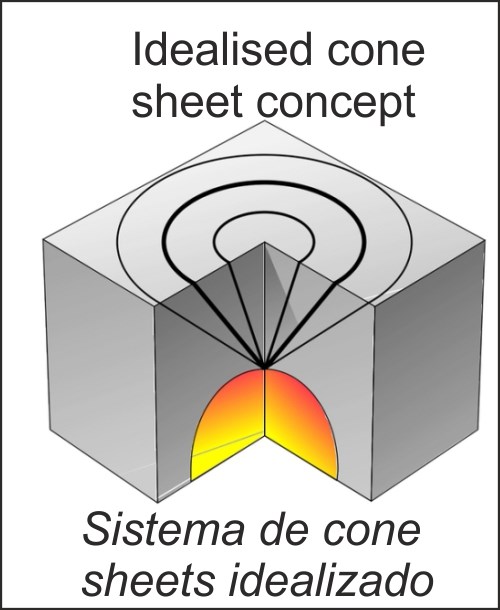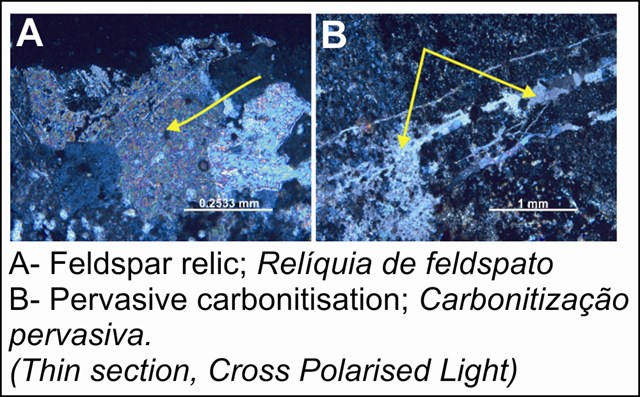|


Como reclamar esta EC:
Nas coordenadas da cache são uma série de camadas de sedimentos / cone sheets. Aqui vais precisar de um clinómetro (ver AQUI para rever os conceitos de estratificação e como fazer um clinómetro ou se tiveres um Adroid smartphone faz download da applicação "clinometer"), uma bússola e uma régua para conseguires responder às perguntas.
1 - Quais são as duas cores que predominam nos rochas aflorantes? (Cinzento-rosa), (Cinzento -Verde), (Roxo-Amarelo), (Castanho escuro- Castanho claro), (Amarelo-Laranja) ou (Cinzento escuro -Amarelo)
2 – Qual é a inclinação dos sedimentos aflorantes (medidos em graus).
3 - Aplicar a lei da superposição e o resultado obtido na pergunta 2, em que direcção ficam os sedimentos mais recentes? (Aqui é necessário um ponto cardeal)
4 - Qualquer foto da paisagem em redor é bem-vinda. Qualquer foto dos sedimentos é considerado um spoiler e não são bem-vindas.
Enviem-me as respostas para o mail leinadoligc@gmail.com . Caso as respostas estejam correctas o log mantem-se, caso não, serão contactados posteriormente.
Enquadramento geológico
A Serra de Sintra, localizada 30 km a oeste do centro da cidade de Lisboa, tem 10 km de comprimento e 5 km de largura. O ponto oeste da montanha é truncado pelos penhascos do Cabo da Roca com 150 m de altura. A altura máxima acima do nível médio do mar é 528 m no V.G. Cruz Alta.
A sua formação inicia-se a cerca de 90 milhões de anos, quando no período Cretácico Superior, um corpo menos denso magma granítico foi impulsionado para cima através das litologias de idade Jurássica já depositadas (essencialmente calcários) e solidificou para permitir que os mortais comuns possam disfrutar das maravilhosas vistas a partir desta massa de granito.
Princípio da sobreposição das camadas
Princípio da sobreposição das camadas, ou Princípio da Superposição, é um princípio da estratigrafia atribuído a Nicolau Steno que afirma que a deposição dos estratos (sedimentação) ocorre sempre por ordem cronológica da base para o topo da coluna estratigráfica. Desta forma, numa sucessão de estratos cuja ordem não foi alterada, cada estrato é mais antigo do que aquele que o cobre e mais recente do que aquele que lhe serve de base.
 Cone sheets Cone sheets
Cone sheets são intrusões menores dispostos em uma matriz curva ou conjunto, individualmente inclinado para um ponto focal comum. O afunilar para cima e para fora das “folhas” envolve um plano anelar para o conjunto estando a zona central, sobre o foco, desprovida de “folhas”.
Eles são formados pela intrusão de magma em fracturas paralelas às camadas sedimentares.
Neste local as cone sheets, intercalados nos calcários do Jurássico aparentam um "bolo de camadas", composta por faixas de dois tipos de rocha alternada. As cone sheets agora "congeladas" são na sua maioria compostas de material muito fino com relíquias de feldspatos e subsequente forte carbonatisação.

The lesson associated in this EarthCache is what cone sheets look like and how they are formed. Additionally, the law of superposition is added to the lesson.
How to claim this EC:
@ The cache coordinates are a series of layered sediments/cone sheets. Here you need a clinometer (See HERE to review the concepts of how dip and strike is measured and how to make your own clinometer or if you have an Android phone, download the free App "clinometer"), a compass and a ruler to proceed further.
- What two colours predominate in the outcropping sediments? (Grey-Pink), (Grey-Green), (Purple-Yellow), (dark Brown-light Brown), (Yellowish- Orange) or (dark Grey- Pink)
- Taking your clinometer, measure the dip of these sediments.
- Applying the law of superposition and the result obtained in question 2, which way are sediments getting younger? (a compass point is required here)
Any scenic photo is a welcome addition (voluntary). Any photo of the sediments is a spoiler and NOT welcome.
Please send the answers to these tasks to leinadoligc@gmail.com . If they’re correct, your log will stand and you won’t hear from me, otherwise be sure that you will contacted.
Geological setting
The Sintra Mountain, located 30 km west of the Lisbon city centre, is 10 km long and 5 km wide. In the west the mountain is truncated by 150 m-high sheer cliffs at Cabo the Roca. The maximum height above mean sea level is 528 m at Cruz Alta.
All this is possible because at around 90 million years, when in the Upper Cretaceous period, a body of less dense granitic magma propelled itself upwards through the existing Jurassic lithologies (essentially limestones) and solidified at just the right spot to allow mere mortals to enjoy the wonderful views from this mass of granite as well as text book examples of some geological features.
The upheaval of this mass of rock has caused the adjacent Jurassic lithologies, that were originally horizontal to become ever more inclined as you move towards the contact of the limestones and granite.
The Law of superposition
The law of superposition (or the principle of superposition) was formulated in the 17th century by the Danish scientist Nicolas Steno and is a key axiom based on observations of natural history that is a foundational principle of sedimentary stratigraphy and so of other geology dependent natural sciences.
In its simplest form it says: Sedimentary layers are deposited in a time sequence, with the oldest on the bottom and the youngest on the top.
Cone sheets
Cone sheets are minor intrusions arranged in a curving array or set, individually inclined rather steeply towards a common focal point. The upward and outward splay of the sheets entails an annular plan for a set as a unit, or an arcuate plan where the sheets are partially developed; there is a central area, over the focus, devoid of sheets.
They are formed by the intrusion of magma into stress fractures parallel to bedding. The stresses separate the natural zones of weakness that are the bedding planes, forcing magma into the plane and forcing the host rock apart.
In this location the cone sheets interlayered within the Jurassic limestones appear as a “layer cake” made up of alternating bands of two rock types. The now “frozen” cone sheets are mostly made up of very fine material with relics of feldspars and subsequent carbonatisation.

Source material
Magee, C. 2011. Emplacement of subvolcanic cone-sheet intrusions. PhD Thesis, University of Birmingham (Unpubl.), 352p.

|